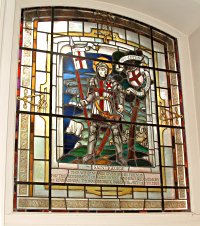Location
On the South wall of the church.

THIS WINDOW WAS GIVEN BY HIS FRIENDS FOR THE
ADORNMENT OF GOD'S HOUSE & IN HONOURED MEMORY
OF REAR ADMIRAL THOMAS FREDERICK PARKER CALVERT CB CVO DSO
Further Information
The window dedicated to Rear Admiral Thomas Calvert was commissioned from the artist Francis H Spear in 1939. Spear planned to show St George in the window and included in the design are the Words Loyalty, Courage and Endurance which Spear felt applied to both St George and the Admiral. The window was damaged in WW2 but was repaired and replaced in 1946.
Information from "St Ann's Church, A Brief History" by Wendy Smith
Service Career
Midshipman, HMS GLORY, China 1900-1901; Sub Lt, HMS IMPLACABLE, Mediterranean 1904; World War I 1914-1918; Lt Cdr, HMS IRON DUKE 1914; Capt, Training and Staff Duties Div, Admiralty 1923; in charge of Air Section, Naval Staff 1924-1926; commanded HMS FROBISHER 1926-1928; Director, RN Staff College, Greenwich 1930-1932; commanded HMS RENOWN 1932-1933; Chief of Staff, Home Fleet 1933-1935; commanded 2 Cruiser Sqn 1936-1938.
Loyalty, Courage, Endurance
The following contribution was sent by Dr. Silvia Ribelles who is researching the Spanish Civil War and the involvement of the Royal Navy
"Rear admiral T.P. Calvert was the commander of the HMS Southampton, a cruiser built in 1935, that breasted the waves of the Bay of Biscay during the month of October, 1937. From what I could read in the reports that he himself wrote on board the Southampton, he was one of the very few officers that showed a strict and utter detachment from the drama that was going on in Spain, in the sense that he did not show any preferences for any contending side. Other officers could not help being in favour of one side or the other, and one can tell those preferences just by reading the reports of proceedings. Rear Admiral Calvert was, I believe, 100% neutral, and that shows the real professional.
On the 21st of October the last important town of the north of Spain collapsed, Franco's troops entered the city, and people frantically abandoned that harbour of Gijon, risking their lives, trying desperately to get to France. The sea was the only way out. HMS Southampton rescued 3 crafts with a total of 370 people on board, between the 23rd and 26th of October, 1937. These people had abandoned the last Spanish harbours (Luanco and Gijon) on the 21st. I have found a film, taken from the British Cruiser by Rear Admiral Calvert of the rescue of one of the boats (the "Aurora"), and there are also a few shots of the rescuees on board the British Man-of-war being fed and catered for. T.P. Calvert has been an enigma for me."
